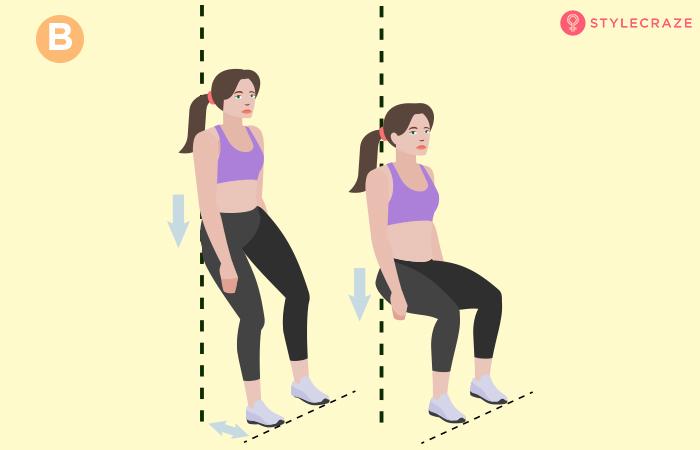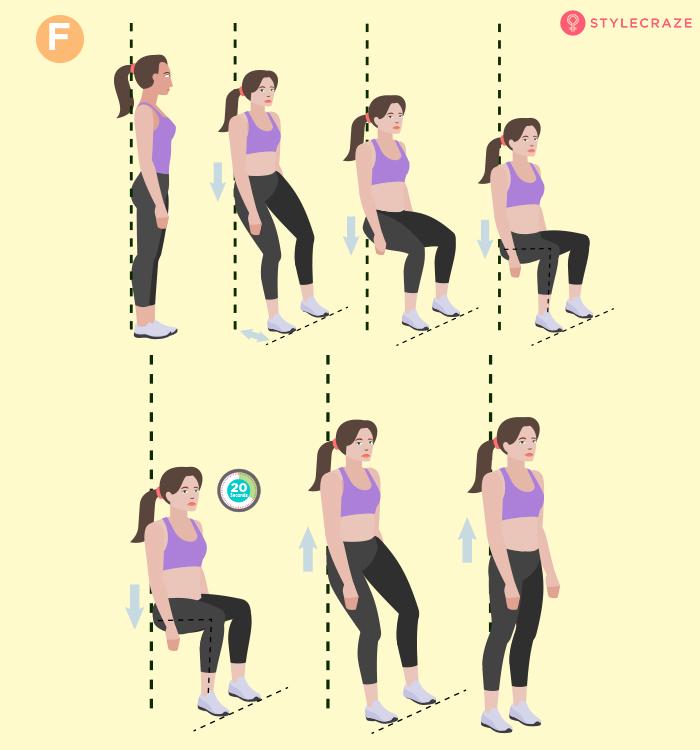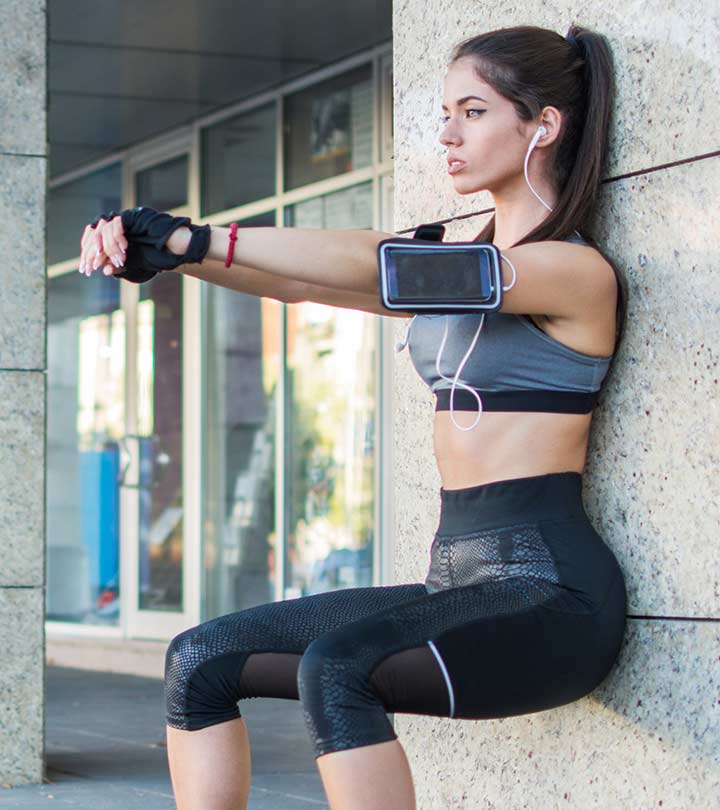Have you ever wondered if wall sits can help you burn belly fat? Well, you’re not alone! Many people are curious about whether this popular exercise can specifically target and tone their abdominal area. In this article, we’ll dive into the topic and explore whether wall sits are effective for burning belly fat. So, if you’re looking to strengthen your core and achieve a flatter stomach, keep on reading!
When it comes to burning belly fat, there’s no magic exercise that can solely target that area. However, wall sits can be a great addition to your workout routine for several reasons. Firstly, they engage multiple muscles, including your quadriceps, hamstrings, and glutes.
This means that wall sits help to build overall strength and increase your metabolism, which can contribute to overall fat burning. Additionally, by holding a static position for an extended period, wall sits challenge your core muscles, helping to tone and define your abs.
So, while wall sits alone may not directly burn belly fat, they can certainly be a valuable part of your fitness routine. In our upcoming article, we’ll delve even deeper into the best exercises for targeting belly fat, so stay tuned!

What are wall sits?
Wall sits, also known as wall squats or wall chairs, are an effective exercise for strengthening and toning your lower body muscles. They involve holding a seated position against a wall, with your knees bent and your back pressed against the wall. This static exercise primarily targets your quadriceps, hamstrings, and glutes, but it also provides benefits for your core muscles and overall fitness.
Definition of wall sits
Wall sits are performed by placing your back against a wall, sliding down into a seated position, and holding that stance for a certain period of time. The goal is to maintain the seated position with your thighs parallel to the ground, forming a right angle with your lower legs. This exercise is generally recommended for people of all fitness levels, as it can be modified to suit individual needs and abilities.
How do wall sits work?
Performing wall sits engages several muscle groups and requires stability and endurance. Here’s how wall sits work:
Engaging core muscles
While wall sits primarily target the lower body muscles, they also engage your core muscles. Holding the seated position against the wall requires you to contract your abdominal muscles, specifically your transverse abdominis and obliques, to maintain stability and keep your upper body upright. This engagement of the core muscles helps strengthen your midsection and can contribute to improved posture and overall stability.
Activating leg muscles
Wall sits mainly focus on the muscles of your lower body, particularly the quadriceps, hamstrings, and glutes. The quadriceps, located at the front of your thighs, are the primary muscles used to hold the seated position against the wall. As you slide down and lower your body, these muscles contract and work to keep your knees bent at a 90-degree angle. The hamstrings and glutes, on the other hand, are responsible for assisting the quadriceps and providing additional support to maintain the seated stance.

Can wall sits target belly fat?
Many individuals wonder if wall sits can specifically target belly fat. It’s important to understand that spot reduction, which is the idea of targeting fat loss in a specific area of the body, is not possible through exercise alone. However, incorporating wall sits into your fitness routine can support overall weight loss and contribute to a reduction in belly fat when combined with a balanced diet and other fat-burning exercises.
Understanding belly fat
Belly fat, also known as visceral fat, is the excess fat stored around the abdominal organs. It is considered a risk factor for various health conditions, including cardiovascular disease and type 2 diabetes. To effectively reduce belly fat, an overall reduction in body fat percentage is necessary. This can be achieved through a combination of regular exercise, a nutritious diet, and a healthy lifestyle.
Role of wall sits in burning belly fat
Wall sits can indirectly contribute to the reduction of belly fat by increasing your overall calorie expenditure and promoting muscle development. Regularly performing wall sits can help strengthen and tone your lower body muscles, including the quadriceps, hamstrings, and glutes, which are large muscle groups. Engaging these muscles during wall sits requires energy and burns calories, helping to create a calorie deficit necessary for weight loss. Additionally, building muscle mass can increase your resting metabolic rate, leading to a higher calorie burn throughout the day.
Benefits of wall sits for overall fitness
Incorporating wall sits into your workout routine offers a wide range of benefits beyond just burning belly fat. Here are some of the advantages of wall sits for overall fitness:
Improving lower body strength
Wall sits primarily target the muscles of the lower body, including the quadriceps, hamstrings, and glutes. Regularly performing wall sits can help strengthen and tone these muscles, leading to improved leg strength, stability, and balance. Strengthening the lower body can also enhance athletic performance and reduce the risk of injuries, particularly in activities that involve running, jumping, or squatting.
Enhancing posture
Maintaining proper posture is essential for overall health and wellbeing. Wall sits require you to keep your back pressed against the wall, promoting spinal alignment and proper posture. This exercise targets the muscles that support your spine and can help alleviate back pain caused by poor posture. By practicing wall sits regularly, you can develop postural awareness and improve your standing and sitting posture throughout the day.
Increasing endurance
Wall sits are a static exercise, which means you hold a position for a specific period of time without movement. As you progress with wall sits, you can gradually increase the duration of the exercise, challenging your endurance capabilities. By consistently pushing your limits and increasing the time you can hold the seated position against the wall, you can enhance your muscular endurance. Improved muscular endurance can benefit various physical activities, allowing you to perform tasks for longer periods without fatigue.
How to perform wall sits correctly?
To get the most out of wall sits and avoid injury, it’s essential to perform the exercise correctly. Here’s a step-by-step guide to performing wall sits correctly:
Preparation
- Find a clear wall space where you can comfortably lean your back against.
- Stand with your back against the wall, ensuring your feet are hip-width apart and positioned slightly in front of you.
- Adjust your feet as necessary to maintain a stable base and allow for a full range of motion.
Execution
- Slowly slide your back down the wall and bend your knees, lowering your body into a seated position.
- Aim to form a right angle with your lower legs, with your thighs parallel to the ground.
- Distribute your body weight evenly through your feet and keep your heels on the ground.
- Keep your back pressed against the wall, engaging your core muscles to maintain an upright posture.
- Relax your shoulders and keep your head aligned with your spine.
- Hold the seated position for a predetermined amount of time, starting with 30 seconds and gradually working your way up.
Tips for proper form
To maximize the effectiveness of wall sits and prevent unnecessary strain or injury, consider the following tips for proper form:
- Focus on your breathing: Take deep breaths throughout the exercise to oxygenate your muscles and maintain a relaxed state.
- Avoid rounding your shoulders: Keep your shoulders back and down, away from your ears, to maintain proper upper body alignment.
- Engage your core: Contract your abdominal muscles throughout the exercise to keep your spine stable and prevent excessive arching of the lower back.
- Keep your knees aligned: Ensure your knees are aligned with your toes and avoid allowing them to collapse inward or push too far forward.
- Start with shorter durations: If you’re new to wall sits or have any existing knee or hip issues, begin with shorter durations and gradually increase the time as your strength and endurance improve.
- Listen to your body: If you experience any pain or discomfort during wall sits, adjust your position or stop the exercise. It’s important to listen to your body and avoid pushing through excessive pain.
Incorporating wall sits into a workout routine
Wall sits can be effectively integrated into a larger workout routine, either as a standalone exercise or as part of a full-body workout. Here are a few ways to incorporate wall sits into your fitness regimen:
Including wall sits in a full-body workout
If you prefer to have a dedicated leg day, you can include wall sits as one of the exercises in your lower body workout routine. Perform wall sits after other compound exercises like squats, lunges, or deadlifts to target your leg muscles. Aim to complete three sets of wall sits, gradually increasing the duration of each set as you progress.
Adding variations for increased intensity
To increase the challenge of wall sits and target additional muscle groups, you can incorporate variations into your routine. Some variations include performing wall sits with a stability ball between your lower back and the wall, holding a weight plate or dumbbells on your lap, or adding leg lifts or calf raises while holding the seated position.

Additional exercises to complement wall sits
While wall sits are a beneficial exercise for your lower body and core, adding complementary exercises can enhance your overall fitness and fat-burning potential. Here are a few exercises to consider incorporating alongside wall sits:
Abdominal exercises
To further target your core muscles and strengthen your abdominal region, consider adding exercises such as planks, crunches, or Russian twists to your routine. These exercises can help you develop a stronger core and enhance muscle definition in your midsection.
Cardiovascular exercises
Cardiovascular exercises, such as brisk walking, running, cycling, or swimming, are excellent for burning overall body fat, including belly fat. Including cardiovascular exercises in your routine can help increase calorie expenditure, elevate your heart rate, and contribute to an overall calorie deficit necessary for weight loss.
Are wall sits alone enough to burn belly fat?
While wall sits can be a valuable addition to your fitness routine, they should not be solely relied upon to burn belly fat. To effectively reduce belly fat, it’s essential to focus on overall weight loss through a combination of regular exercise, a balanced diet, and a healthy lifestyle.
Importance of a balanced diet
Nutrition plays a critical role in fat loss. To effectively reduce belly fat and achieve a healthy body weight, it’s important to follow a balanced diet that provides adequate nutrients while promoting calorie deficit. Focus on consuming whole, nutrient-dense foods such as lean proteins, fruits, vegetables, whole grains, and healthy fats. Reduce your intake of processed foods, sugary beverages, and excessive calorie-dense foods.
Incorporating other fat-burning exercises
While wall sits engage your leg muscles and can contribute to overall calorie burn, incorporating a variety of exercises that target different muscle groups can enhance your fat-burning potential. Include exercises like resistance training, cardiovascular exercises, and high-intensity interval training (HIIT), along with wall sits, to maximize your calorie expenditure, improve body composition, and promote overall fat loss.

Precautions and considerations
Before incorporating wall sits or any new exercise into your routine, it’s important to consider the following precautions:
Consulting a healthcare professional
If you have any existing medical conditions or injuries, it’s recommended to consult with a healthcare professional or a qualified fitness trainer before performing wall sits or making significant changes to your exercise routine. They can provide personalized advice and help you determine if wall sits are appropriate for your individual needs.
Listening to your body
Pay attention to any pain or discomfort during wall sits. If you experience sharp or intense pain in your knees, hips, or lower back, it may indicate improper form or an underlying issue. Stop the exercise and consult a professional if the pain persists or worsens. Additionally, modify the exercise to suit your fitness level and gradually increase the duration or intensity over time.
Conclusion
Wall sits are a beneficial exercise for strengthening and toning your lower body muscles, engaging your core, and improving overall fitness. While they may indirectly contribute to the reduction of belly fat by increasing your calorie expenditure and promoting muscle development, they should not be solely relied upon as a means to burn belly fat.
To achieve significant belly fat reduction, it’s important to combine wall sits with a balanced diet, other fat-burning exercises, and a healthy lifestyle. Incorporating wall sits into your workout routine can support overall weight loss, improve lower body strength, enhance posture, and increase endurance.
Remember to perform wall sits with proper form, listen to your body, and consult a professional if needed. So, go ahead and add wall sits to your fitness routine for a well-rounded approach to better health and fitness.




